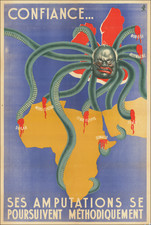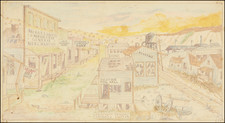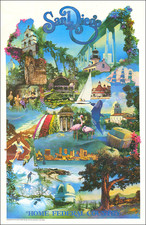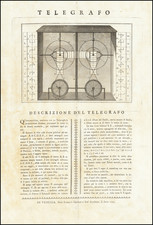Fascinating complete set of 12 posters, plus title page and credits page, published the Кукрыниксы (Kukryniksy) art collective,a famous and enduring trio of Soviet satirical artists, whose work spanned almost the entirety of the history of the Soviet Union.
Kukryniksy is an acronym for a group of three Soviet illustrators and caricaturists consisting of Mikhail Vasilyevich Kupriyanov (1903-1991), Porfiri Nikitich Krylov (1902-1990) and Nikolai Alexandrovich Sokolov (1903-2000). - Sergei Vasilyevich Smirnov (1912-1993) wrote patriotic poems in the spirit of socialist realism. - Somewhat crease
The present series was issued in 1975, in the same year the trio was awarded the State Prize of the USSR.
This series of satirical illustrations by Kukryniksy features a collection of caricatures paired with humorous poems, critiquing various aspects of Soviet society, particularly focusing on human flaws and societal issues. Each image portrays a distinct character or situation, using exaggerated and grotesque imagery to emphasize the critique. Below is a summary of the content and themes of each image:
-
"Aggregate of a Parasite" - Criticizes laziness and parasitism, depicting a man with spoon and fork arms symbolizing his only focus on eating without effort.
-
"Specialist-Drinker" - Highlights the detrimental effects of alcoholism, showing a man with a vodka bottle for a head, emphasizing how drinking undermines productivity.
-
"Anonymous Figure (Don’t Pass By!)" - Condemns deceit and anonymity, showing a man with a newspaper over his face, symbolizing hidden dishonesty.
-
"Sloppy Marriage Worker" - Critiques incompetence and poor quality, depicting a man in absurd clothing, symbolizing a trendsetter of mediocrity.
-
"Particularly Harmful Person" - Depicts corruption and theft, showing a man stealing from a safe, highlighting dishonest behavior and its impact.
-
"Greedy and His Service" - Satirizes corruption and bribery, illustrating a man taking bribes to provide services, emphasizing systemic corruption.
-
"Memo to Remember" - Advises against rudeness in public service, portraying a rude salesperson, stressing the importance of politeness.
-
"Familiar… 'Insect'" - Critiques gossip and nosiness, showing a woman with insect-like limbs, symbolizing intrusive behavior that should be eradicated.
-
"Dragonfly-Lover" - Satirizes superficial romantic behavior, depicting a man with exaggerated affections, critiquing insincerity in relationships.
-
"Office Exhibit" - Highlights bureaucratic stagnation, showing an ineffective office worker who has become mere furniture, symbolizing lack of productivity.
-
"To the Superior – A Lackey, to the Inferior – A Grandee" - Criticizes hypocrisy and opportunism, showing a man obsequiously bowing to superiors while disdainfully stepping on inferiors.
-
"Strong from All Sides" - Condemns willful ignorance and apathy, depicting a man with button eyes and stitched mouth, symbolizing indifference and uselessness.
Overall, the series uses humor and satire to address serious societal issues such as laziness, alcoholism, deceit, incompetence, corruption, rudeness, nosiness, superficiality, and bureaucratic inefficiency. Through exaggerated caricatures and witty poems, Kukryniksy delivers sharp critiques on human flaws and systemic problems, encouraging reflection and reform.4o
The images include the following:
"Aggregate of a Parasite": «АГРЕГАТ-ТУНЕЯД» Мечта его натуры пылкой — Сидеть, работать ложко-вилкой. Его заглавная черта — Не пронести бы мимо рта! Translation: "AGGREGATE OF A PARASITE" The dream of his ardent nature — To sit, working with a spoon-fork. His main trait — Not to miss his mouth!
This caricature depicts a man with his arms replaced by a spoon and a fork, symbolizing laziness and a lack of productivity. The poem humorously highlights his only goal being to eat without any effort, reflecting a critique of parasitism and idleness.
"Specialist-Drinker": «СПЕЦ-ПЬЕЦ» С чего бы у станка он робко Маячит час, и два, и три? Увы, всему причиной — пробка Плюс сорок градусов внутри. Translation: "SPECIALIST-DRINKER" Why would he timidly stand by the machine For an hour, two, and three? Alas, the reason is — the cork Plus forty degrees inside.
This illustration shows a man whose head is replaced by a vodka bottle, critiquing alcoholism. The poem suggests that his inability to work is due to his drinking habit, symbolizing the detrimental effects of alcohol on productivity and responsibility.
"Anonymous Figure (Don’t Pass By!)" ФИГУРА АНОНИМА (Не проходите мимо!) Глядит вокруг не без опаски. Черты лица — в елейной маске. Но даже так, из-под «лица», Сквозит натура подлеца! Translation: ANONYMOUS FIGURE (Don’t Pass By!) Looks around not without caution. The features of the face — in an oily mask. But even so, from under the "face," The nature of a scoundrel shines through!
This caricature portrays a man with a newspaper over his face, symbolizing deceit and anonymity. The poem describes him as hiding his true nature behind a mask, suggesting dishonesty and treachery. The dripping ink adds to the sense of corruption and moral decay.
"Sloppy Marriage Worker" ПО-ВАЛЬНЫЙ БРАКОГОН Спешит, на все педали жмет Такой «законодатель мод». Увы, завзятый бракодель, Что всем терпеньям есть предел! Translation: SLOPPY MARRIAGE WORKER Hurries, presses all the pedals Such a "fashion legislator." Alas, a confirmed bungler, Who tests everyone’s patience to the limit!
This caricature shows a man in a mix of formal and absurd clothing, symbolizing incompetence. The poem criticizes him for being a trendsetter of poor quality, highlighting his constant errors and the frustration they cause others.
"Particularly Harmful Person": ОСОБО ВРЕДНАЯ ОСОБА — Я,—говорит,— Пекуся изне О государственной казне: Не склонный к честному труду, Акробатически... краду. Translation: PARTICULARLY HARMFUL PERSON — I,—he says,— Care tenderly For the state treasury: Not inclined to honest work, Acrobatically... I steal.
This illustration depicts a man stealing from a safe, symbolizing corruption. The poem highlights his lack of honesty and acrobatic thievery, emphasizing his detrimental impact on society and the state.
"Greedy and His Service": ХАПУГА И ЕГО УСЛУГА Коль вручена хапуге взятка, Все будет «Да», Все будет гладко. Коль взятки нет, Все будет «Нет», Не заходите в кабинет. Translation: GREEDY AND HIS SERVICE If the bribe is given to the greedy, Everything will be "Yes," Everything will be smooth. If there is no bribe, Everything will be "No," Do not enter the office.
This caricature shows a man taking a bribe, symbolizing corruption. The poem satirizes the ease with which officials can be bribed, and how refusal to pay results in denied services, critiquing systemic corruption.
"Memo to Remember" ЗАРУБКА НА ПАМЯТЬ Гражданину продавцу Злая мина не к лицу: Коль общаешься с людьми— Не груби и не хами! Translation: MEMO TO REMEMBER To the citizen seller A sour face does not suit: When dealing with people— Don't be rude and don't be arrogant!
This illustration portrays a salesperson rudely interacting with customers, symbolizing poor customer service. The poem advises against rudeness, emphasizing the importance of politeness and good manners in public service roles.
"Familiar… 'Insect'": ЗНАКОМАЯ… «НАСЕКОМАЯ» У нас, в общественном дому, Сим тварям жить — ни-ни! Давай содействовать тому, Чтоб вымерли они! Translation: FAMILIAR… "INSECT" In our communal house, These creatures must not live — no-no! Let’s help to ensure, That they die out!
This caricature shows a woman with insect-like limbs, symbolizing gossip and nosiness. The poem suggests that such nosy and intrusive behavior should be eradicated, critiquing those who meddle in others' affairs.
"Dragonfly-Lover": СТРЕКОЗЕЛ-МНОГОЛЮБЕЦ Эту—чмок! Вторую—чмок! Третью—любит под шумок... А любовь его одна: Стрекозлиная она! Translation: DRAGONFLY-LOVER This one — smack! The second — smack! The third — loves secretly... But his one true love: Is dragonfly-like!
This caricature portrays a man with exaggerated romantic behavior, symbolizing superficiality in love. The poem humorously describes his fleeting and shallow affections, critiquing insincerity in relationships.
"Office Exhibit": КАБИНЕТНЫЙ ЭКСПОНАТ Он — в «гуще» дел, И кем такой начальник стал? Теперь пред нами просто мебель — Типичный самоделестал. Translation: OFFICE EXHIBIT He was in the "thick" of things, And how did he become such a boss? Now before us is just furniture — A typical self-made.
This caricature depicts an office worker who has become ineffective, symbolizing bureaucratic stagnation. The poem describes him as merely a piece of furniture, highlighting his lack of productivity and impact.
"To the Superior – A Lackey, to the Inferior – A Grandee": К ВЫШЕСТОЯЩЕМУ — ЛАКЕЙ, К НИЖЕСТОЯЩЕМУ — ВЕЛЬМОЖА Служака этот — «мал-велик», При всем при том — всегда двулик. Трещи под ним, карьера-лестница, Пусть он скорей об землю треснется! Translation: TO THE SUPERIOR — A LACKEY, TO THE INFERIOR — A GRANDEE This servant — "small but great," At the same time — always two-faced. Under him, the career ladder cracks, Let him soon fall to the ground!
This caricature depicts a man obsequiously bowing to his superior while disdainfully stepping on an inferior, symbolizing hypocrisy and opportunism. The poem critiques his duplicitous nature and hopes for his downfall, highlighting the instability of his position.
"Strong from All Sides": СИЛЕН СО ВСЕХ СТОРОН Проверь на зоркость и на слух: Он абсолютно слеп и глух. Во всем позиция одна, —
Мол, «Наше дело — сторона». Translation: STRONG FROM ALL SIDES Check for sharpness and hearing: He is absolutely blind and deaf.
In everything, his position is one — They say, "Our business is none of your concern."
This illustration shows a man with button eyes and stitches over his mouth, symbolizing willful ignorance and apathy. The poem describes his complete indifference to everything around him, emphasizing his uselessness and the detrimental effect of such an attitude.
The Kukryniksy (Russian: Кукрыниксы) were three caricaturists/cartoonists in the USSR with a recognizable style.
The Kukryniksy, a celebrated Soviet artistic trio, consisted of Porfirii Nikitich Krylov (1902–1990), Mikhail Vasil’evich Kupriianov (1903–1991), and Nikolai Aleksandrovich Sokolov (1903–2000. The collaboration began in 1922 when Krylov and Kupriianov, then students in the Graphic Department of VKhUTEMAS, started creating cartoons, book illustrations, and poster designs under the pseudonyms Kukry and Krykup. In 1924, Sokolov joined them, and they adopted the collective name Kukryniksy.
The Kukryniksy's work was extensively published across prominent Soviet newspapers, including Pravda, Krasnaia zvezda, Komsomol’skaia pravda, and Literaturnaia gazeta, as well as magazines such as Krokodil, Prozhektor, Smekhach, and Smena. Their distinct style and keen political satire made them fixtures in Soviet visual culture. In 1929, they expanded their influence by designing the sets for Vladimir Maiakovskii’s theatrical comedy The Bedbug.
They became nationally famous in the 1930s after they began drawing for Krokodil, the Moscow satirical paper, during the rise of fascism. They received international recognition for their attacks on Adolf Hitler, Benito Mussolini, Heinrich Himmler, Joseph Goebbels, and Francisco Franco. During the Second World War, they established the TASS Windows for political cartoons and posters. After the end of the Second World War, they continued to depict politics in their series Cold War (1945—1980s).
They illustrated a number of books, including Ilf and Petrov's, Nikolay Gogol, Mikhail Saltykov-Shchedrin, Anton Chekhov, Maxim Gorky, Nikolai Leskov, Miguel de Cervantes.
A typical Kukryniksy caricature of Hitler on an Allied propaganda poster from 1942 exhibited in the now-closed International Museum of World War II.[1]
The Kukryniksy are also authors of Socialist Realism-style paintings concerned with historical, political and propaganda topics.
Their artistic achievements were recognized with numerous prestigious awards, including five Stalin Prizes (1942, 1947, 1949, 1950, and 1951), the Lenin Prize (1965), and the State Prize of the USSR (1975). These honors underscored their significant impact on Soviet art and culture.
The Kukryniksy remain renowned for their dynamic and influential body of work, which spans multiple media and decades. Their unique blend of humor, critique, and artistic skill left an indelible mark on Soviet visual arts, and their legacy continues to be studied and celebrated for its contribution to political satire and propaganda.










![(Mississippi Bubble) Kermis Wind-Kraamer En Grossier [Fair of the wholesale wind-pedlar.]](https://storage.googleapis.com/raremaps/img/small/95945.jpg)

![(Nuremberg Chronicle) [Geneology of the Virgin Mary]](https://storage.googleapis.com/raremaps/img/small/98722.jpg)

